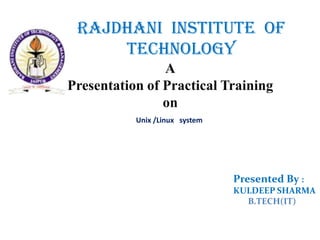
Presentation for RHCE in linux
- 1. RAJDHANI INSTITUTE OF TECHNOLOGY A Presentation of Practical Training on Unix /Linux system Presented By : KULDEEP SHARMA B.TECH(IT)
- 2. History Of UNIX & Linux 1957: Bell Labs found they needed an operating system which at the time was running various batch jobs. 1965: Bell Labs create Multics (Multiplexed Information and Computing Service) 1969: Summer 1969 UNIX was developed by AT&T 1975: Sixth edition of UNIX released May 1975 1985: GNU project started 1991: Linux is introduced by Linus Benedict Torvalds who was a second year student of Computer Science at the University of Helsinki 1993: NetBSD & FreeBSD released 1994: Red Hat Linux is introduced
- 3. Shell • Program that interacts with kernel • Bridge between kernel and the user • Command interpreter • User can type command and the command is conveyed to the kernel and it will be executed Softsmith Infotech
- 4. Linux Shellls whoami pwd Shell interprets the command and Bash, Tcsh, Zsh request service from kernel Similar to DOS but DOS has only one set of interface while Linux can select Kernel different shell – Bourne Again shell (Bash), TC shell (Tcsh), Z shell (Zsh) Different shell has similar but different functionality Bash is the default for Linux Graphical user interface of Linux is in fact an application program work on the shell
- 5. Linux File Types Normal - Normal file Directories d Normal directory Hard link - Symbolic link l Shortcut to a file or directory Socket s Pass data between 2 process Named pipe p Like sockets, user can’t work directly with Character device c Processes character hw communication Block device b Major & minor numbers for controling dev.
- 6. Some of Linux Commands(1) echo man help info ls cat tac cp mv rm cd touch pwd mkdir rmdir clear alias less date logout exit reboot halt
- 7. Basic Commands Commands • su switch user • passwd change password • useradd create new user account • userdel delete user account • mount mount file system • umount unmount file system • df show disk space usage • shutdown reboot or turn off machine
- 8. Some of Linux Commands(3) Create Partitions and Filesystem fdisk, mke2fs, mkfs.* Maintain the Integrity of Filesystem e2fsck, fsck.*, du, df Filesystem Mounting & Umounting mount, umount, /etc/fstab
- 9. ‘vi’ Powerful Text Editor • Insert Text Insert Mode • Delete n+dd (Delete) • dd • yy n+yy (Copy) •p (paste) Normal Mode •P (Paste) •/ (Search) •w • q! • v (Visual) (Text Selection) Command Mode •q •r • wq = x • s///
- 10. All LINUX commands start with the name of the command and can be followed by options and arguments. Linux text-based interface command to show the content of current directory The prompt $ shows that bash shell is using command to show the content of current directory with option -al
- 11. Some of the basic commands you should learn are the ones that help you navigate Commands: the file system. / (root directory) /root – home directory of the user root pwd – you can see your home directory df – to see disk space available cd – to change to different directory or to go back to home dir .. - move to parent directory ls – list the contents of a directory; Options: -l (more info) -a (displays hidden files) -t (sort by time) -r (oldest first) Example: ls –ltr : display an long list of files that are sorted by time, display the oldest ones first
- 12. cp : copy one file to another rm : remove a file man : ask for the manual (or help) of a command e.g. man cd ask for the manual of the command cd cat : to show the content of a text file e.g. cat abc.txt show the content of abc.txt whoami : to show the username of the current user Directory is denoted by a / (slash) character Executable program by a * Hidden file preceded by a . (dot)
- 13. Permission Command • chmod change file mode, add or remove permission • chown change owner of the file Example) chmod a+w filename add writable permission to all users chmod o-x filename remove executable permission from others chmod a+x Gives permission to the usser to execute a file • u: user (owner), g: group,o: others a: all
- 14. Process Management Commands • kill Stop a program. The program is specified by process ID. • killall Stop a program. The program is specified by command name. • ps Show process status • top Show system usage statistics
- 15. Foreground and Background • Running job has two modes, “foreground” and “background” • If program is running as “background”, the program keeps running even after your session was closed • If program is running as “foreground”, Ctrl-C stop program Ctrl-Z let program background
- 16. Foreground and Background • To run programs in background mode, use “&” [nomura@ssc-1]$ command & • To get background job back into foreground mode, use “fg” command. [nomura@ssc-1]$ fg
- 17. Why Use Linux? • Costs less • Stable • Reliable • Extremely powerful
- 18. The Advantage of Linux • Low purchase cost • Open Source Software (OSS) • UNIX heritage • Multi User • Scalability • Vendor support • Reliable uptime • Security • Logging System • …
- 19. The Disadvantage of Linux • Steep learning curve • Hardware support • End-user applications
